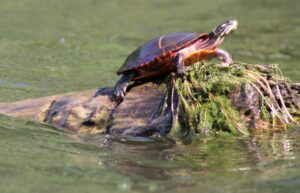A Red Painted Turtle On Rosh Hashanah.
Posted on | September 24, 2022 | Comments Off on A Red Painted Turtle On Rosh Hashanah.
Mike Magee

Tomorrow begins Rosh Hashanah, the Jewish New Year. This is the time when Jewish people ask God for forgiveness for their mistakes and errors over the past year and commit to learning from those mistakes as to not repeat them in the year ahead. The emphasis then is not on suffering, but on hope. And the remedies prescribed include “prayer, charity, and repentance” to be exercised in the 10-day period between the beginning of Rosh Hashanah and the end of Yom Kippur, the solemn fasting Day of Atonement, that this year extends from sunset on October 4 until after nightfall on October 5th.
The pinnacle of the liturgy, and the right notes of solemnity, according to many experts, is the Unetaneh Tokef, a poem focused on the judgement day for humanity, forecast as both “awesome and terrible.”
The poem recites out loud (in part) the questions we dare not ask.
How many shall pass away and how many shall be born,
Who shall live and who shall die,
Who shall reach the end of his days and who shall not,
Who shall perish by water and who by fire,
Who by sword and who by wild beast,
Who by famine and who by thirst,
Who by earthquake and who by plague,
Who by strangulation and who by stoning,
Who shall have rest and who shall wander,
Who shall be at peace and who shall be pursued,
Who shall be at rest and who shall be tormented,
Who shall be exalted and who shall be brought low,
Who shall become rich and who shall be impoverished.
But repentance, prayer and righteousness avert the severe decree.”
The Unetaneh Tokef entered the public culture for many as part of Leonard Cohen’s 1974 album, “New Skin for the Old Ceremony.” In that album, Cohen offers his version or take on the ancient and poetic prayer which resonates in an eerily familiar and contemporary way. Think an unpredictable pandemic and an utterly predictable Putin, forest fires and flooded streets, Sackleristic greed and our manmade opioid epidemic.
Cohen voices our despair in a single line: “And who shall I say is calling?”
Listen to these verses:
And who by fire, who by water
Who in the sunshine, who in the night time
Who by high ordeal, who by common trial
Who in your merry merry month of May
Who by very slow decay
And who shall I say is calling?
And who in her lonely slip, who by barbiturate
Who in these realms of love, who by something blunt
And who by avalanche, who by powder
Who for his greed, who for his hunger
And who shall I say is calling?
And who by brave assent, who by accident
Who in solitude, who in this mirror
Who by his lady’s command, who by his own hand
Who in mortal chains, who in power
And who shall I say is calling?
Yesterday, I took my 38 pound, 10 foot kayak, which fits inside my CRV, ten minutes away to a little pond in Avon, Ct. I had just read a piece on ecopsychology.
That’s the study of how nature, and humans immersion in it, benefits human health. That’s the raison d’être of an online magazine at Yale called Yale Environment 360. It’s a project published by Yale School of Environment which enjoys the support of the Ford Foundation, William Penn Foundation, and many others.
In 2020, they asked themselves “How long does it take to get a dose of nature high enough to make people say they feel healthy and have a strong sense of well-being?” After studying 20,000 people systematically, they had their answer. “Precisely 120 minutes” per week in a green space – whether a park, a small back yard, or the truly wild.
Unlike many health treatments, there were no significant disparities in the impact on feelings of healthiness these outings evoked. Ethnicity, occupation, poverty level, presence or absence of disability or chronic disease did not discriminate. The “calling” was ecumenical.
And yet each person’s journey, destination, and outcome is different. For me that day it was the the “calling” above, a red painted turtle (Chrysemys picta) on a log, similar to the many I had encountered as a young boy, exploring on a small lake, on my own, in northern New Jersey. It allowed me to quietly approach it, close enough to shoot the picture above, and share it (its vibrant colors, its sunshine reflection, its free spirit, and its full display of its own many ordeals) with you.
Happy Rosh Hashanah.


